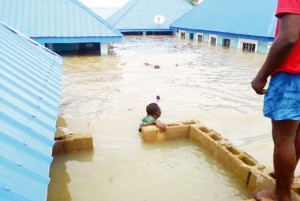The recently released report of “The 2012 Flood Impact Assessment” of Benue State conducted by the Benue Non-governmental Organisation Network (BENGONET) with support from United Nations Development Programme (UNDP) and the Benue State Government aims to bring to the fore the extent of the damage caused by the flood and the need to carryout interventions that will mitigate its effects on the lives of those involved as well as put in place adequate measures to prevent its re-occurrence and evolve better strategies for managing such situations in future.

With the release of excess water from the Lagdo Dam in the Republic of Cameroun, several states in Nigeria witnessed heavy flooding especially those with rivers passing through them.
Benue State, which has the River Benue as a major river passing through it and other smaller rivers and tributaries, experienced severe flooding which cut across all its major towns on the bank of the river and its tributaries. Indeed, the flood ravaged and swept way anything within a 10-kilometre radius of the bank of the river between September and October 2012, the peak period of the flood.
The devastation, which sacked communities in Makurdi, Apa, Agatu, Otukpo, Guma, Buruku, Tarka and Kasina-Ala local government areas (LGAs) of the state, left on its trail over 700,000 displaced persons with thousands of farmlands, houses and huts either submerged or washed away.
In response to the flooding, the Benue State Government created camps for the displaced in Makurdi metropolis where those who were rendered homeless by the devastation went to seek shelter. Primary schools within Makurdi were closed and turned into camps where the displaced persons lived and survived on goodwill donations from charity organisations, religious bodies, non-governmental (NGOs), donor agencies, governmental agencies and public-spirited individuals.
According to the report, the flood had a devastating impact on the affected people, houses and environment. Private and public buildings were affected by the water which, in most instances, rose up to the window and even completely submerged buildings in some locations.
Refuse was washed from dump sites into people’s homes and sewage was flooded into sources of water in most areas affected by the flood. Farmlands were washed away and vegetation was either swept away or withered away due to excess water.
The camps that were set up by the government could not adequately cater for the needs of those families that ran to them. Toilet facilities were not adequately provided for in the camps and water supply was an issue in most of the camps.
Though there were warnings about the flood, the government’s response showed a lot of unpreparedness for the floods when they eventually came. It was as if the government did not heed the warnings of the flood. The failure of the government to heed repeated warnings and properly prepare for severe flooding resulted in far more damage and hardship than was necessary
Most of the victims who went to the camps complained that the camp officials kept most of the items donated by public-spirited individuals/philanthropists for themselves. Most of the areas affected were those located near the banks of the river or its flood plains.
Also, most of the victims were traumatised, helpless and depressed as a result of the floods. This put a strain on families and the relationship between members of families.
Lots of properties were lost to the flood. Most families, even as at the time of the conduct of the survey, could not come to terms with the reality that they had lost so much to the flood. Electronics, domestic animals, vehicles and other properties were either damaged beyond repairs or washed away by the flood.
Businesses, farmlands and other means of livelihood were destroyed by the flood, leaving most families with nothing to fall back on even after the flood.
It is believed that women and children suffered the most. Women were not provided with sanitary commodities and the absence/inadequacy of toilets and water hit them very hard. Most women were torn between looking after their children and catering for themselves during the period, which put a strain on them emotionally.
The men, the report states, had to undergo a lot of stress and pressure as they had to constantly experience anxiety about catering for their families in terms of looking for shelter and providing for other essential needs of the family and managing the situation. There were also unconfirmed reports of rape on some of the females.
The report states that, though the flood has come and gone, the impact and effects on the people is still being felt by those that were directly involved. The government, civil society organisations and public-spirited individuals should intervene to bring succour to those that were directly affected by the flood.
The removal of refuse from some of the affected areas has not been done till today. Government agencies responsible should be reminded of their responsibility to those in the affected areas where refuse was washed from dump sites to residential areas.
If not in place already, government should develop a disaster management blueprint and get its agencies responsible for response to disaster acquainted with such a document. The state’s response to the flood showed a blatant unpreparedness.
Similarly, government should make efforts towards supporting flood victims, nurturing economic growth, restoring infrastructure and re-establishing and protecting the environment.
Government should relocate houses built close to the river bank, while enacting legislation that would ban new development in floodplains.
Government should embark on the construction of new drainage channels, canals and aggressive expansion of existing ones within the areas affected to enhance the free flow of water.
